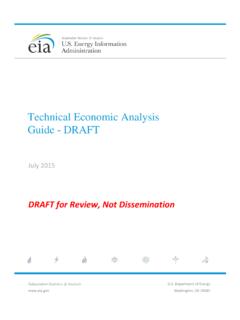Transcription of Technical Analysis: Introduction
1 Technical analysis : Introduction Tutorials Technical analysis : Introduction The methods used to analyze securities and make investment decisions fall into two very broad categories: fundamental analysis and Technical analysis . Fundamental analysis involves analyzing the characteristics of a company in order to estimate its value. Technical analysis takes a completely different approach; it doesn't care one bit about the "value" of a company or a commodity. Technicians (sometimes called chartists) are only interested in the price movements in the market . Despite all the fancy and exotic tools it employs, Technical analysis really just studies supply and demand in a market in an attempt to determine what direction, or trend, will continue in the future. In other words, Technical analysis attempts to understand the emotions in the market by studying the market itself, as opposed to its components.
2 If you understand the benefits and limitations of Technical analysis , it can give you a new set of tools or skills that will enable you to be a better trader or investor. In this tutorial, we'll introduce you to the subject of Technical analysis . It's a broad topic, so we'll just cover the basics, providing you with the foundation you'll need to understand more advanced concepts down the road. Technical analysis : The Basic Assumptions What Is Technical analysis ? Technical analysis is a method of evaluating securities by analyzing the statistics generated by market activity, such as past prices and volume. Technical analysts do not attempt to measure a security's intrinsic value, but instead use charts and other tools to identify patterns that can suggest future activity.
3 Just as there are many investment styles on the fundamental side, there are also many different types of Technical traders. Some rely on chart patterns, others use Technical indicators and oscillators, and most use some combination of the two. In any case, Technical analysts' exclusive use of historical price and volume data is what separates them from their fundamental counterparts. Unlike fundamental analysts, Technical analysts don't care whether a stock is undervalued - the only thing that matters is a security's past trading data and what information this data can provide about where the security might move in the future. The field of Technical analysis is based on three assumptions: 1. The market discounts everything. 2. Price moves in trends. 3. History tends to repeat itself.
4 1. The market Discounts Everything A major criticism of Technical analysis is that it only considers price movement, ignoring the fundamental factors of the company. However, Technical analysis assumes that, at any given time, a stock's price reflects everything that has or could affect the company - including fundamental factors. Technical analysts believe that the company's fundamentals, along with broader economic factors and market psychology, are all priced into the stock, removing the need to actually consider these factors separately. This only leaves the analysis of price movement, which Technical theory views as a product of the supply and demand for a particular stock in the market . 2. Price Moves in Trends In Technical analysis , price movements are believed to follow trends.
5 This means that after a trend has been established, the future price movement is more likely to be in the same direction as the trend than to be against it. Most Technical trading strategies are based on this assumption. 3. History Tends To Repeat Itself Another important idea in Technical analysis is that history tends to repeat itself, mainly in terms of price movement. The repetitive nature of price movements is attributed to market psychology; in other words, market participants tend to provide a consistent reaction to similar market stimuli over time. Technical analysis uses chart patterns to analyze market movements and understand trends. Although many of these charts have been used for more than 100 years, they are still believed to be relevant because they illustrate patterns in price movements that often repeat themselves.
6 Not Just for Stocks Technical analysis can be used on any security with historical trading data. This includes stocks, futures and commodities, fixed-income securities, forex, etc. In this tutorial, we'll usually analyze stocks in our examples, but keep in mind that these concepts can be applied to any type of security. In fact, Technical analysis is more frequently associated with commodities and forex, where the participants are predominantly traders. Now that you understand the philosophy behind Technical analysis , we'll get into explaining how it really works. One of the best ways to understand what Technical analysis is (and is not) is to compare it to fundamental analysis . We'll do this in the next section. Technical analysis : Technical vs. Fundamental analysis Technical analysis and fundamental analysis are the two main schools of thought in the financial markets.
7 As we've mentioned, Technical analysis looks at the price movement of a security and uses this data to predict its future price movements. Fundamental analysis , on the other hand, looks at economic factors, known as fundamentals. Let's get into the details of how these two approaches differ, the criticisms against Technical analysis and how Technical and fundamental analysis can be used together to analyze securities. The Differences Charts vs. financial Statements At the most basic level, a Technical analyst approaches a security from the charts, while a fundamental analyst starts with the financial statements. (For further reading, see Introduction To Fundamental analysis and Advanced financial Statement analysis .) By looking at the balance sheet, cash flow statement and income statement, a fundamental analyst tries to determine a company's value.
8 In financial terms, an analyst attempts to measure a company's intrinsic value. In this approach, investment decisions are fairly easy to make - if the price of a stock trades below its intrinsic value, it's a good investment. Although this is an oversimplification (fundamental analysis goes beyond just the financial statements) for the purposes of this tutorial, this simple tenet holds true. Technical traders, on the other hand, believe there is no reason to analyze a company's fundamentals because these are all accounted for in the stock's price. Technicians believe that all the information they need about a stock can be found in its charts. Time Horizon Fundamental analysis takes a relatively long-term approach to analyzing the market compared to Technical analysis .
9 While Technical analysis can be used on a timeframe of weeks, days or even minutes, fundamental analysis often looks at data over a number of years. The different timeframes that these two approaches use is a result of the nature of the investing style to which they each adhere. It can take a long time for a company's value to be reflected in the market , so when a fundamental analyst estimates intrinsic value, a gain is not realized until the stock's market price rises to its "correct" value. This type of investing is called value investing and assumes that the short-term market is wrong, but that the price of a particular stock will correct itself over the long run. This "long run" can represent a timeframe of as long as several years, in some cases. (For more insight, read Warren Buffett: How He Does It and What Is Warren Buffett's Investing Style?)
10 Furthermore, the numbers that a fundamentalist analyzes are only released over long periods of time. financial statements are filed quarterly and changes in earnings per share don't emerge on a daily basis like price and volume information. Also remember that fundamentals are the actual characteristics of a business. New management can't implement sweeping changes overnight and it takes time to create new products, marketing campaigns, supply chains, etc. Part of the reason that fundamental analysts use a long-term timeframe, therefore, is because the data they use to analyze a stock is generated much more slowly than the price and volume data used by Technical analysts. Trading Versus Investing Not only is Technical analysis more short term in nature that fundamental analysis , but the goals of a purchase (or sale) of a stock are usually different for each approach.

















